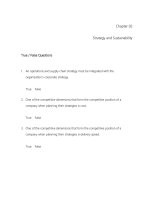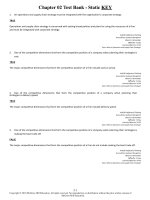Lecture International business (11/e) - Chapter 19: Global operations and supply chain management
Bạn đang xem bản rút gọn của tài liệu. Xem và tải ngay bản đầy đủ của tài liệu tại đây (407.96 KB, 36 trang )
chapter nineteen
Global Operations and Supply
Chain Management
McGrawHill/Irwin
International Business, 11/e
Copyright © 2008 The McGrawHill Companies, Inc. All rights reserved.
Learning Objectives
• Understand the concept of supply chain management
• Recognize the relationship between design and supply
chain management
• Describe the five global sourcing arrangements
• Appreciate the importance of added costs of global
sourcing
• Understand the increasing role of electronic
purchasing for global sourcing
• Understand the just-in-time (JIT) production system
and potential problems with its implementation
19-3
Chapter Objectives
Understand synchronous manufacturing and
customization
Comprehend the concept of Six Sigma systems and
their application
Explain the potential of global standardization of
production processes and procedures, and identify
impediments to standardization efforts
Know the two general classes of activities in
19-4
manufacturing systems, productive and supportive,
Supply Chain Management
• Process of coordinating and integrating
the flow of materials, information,
finances, and services within and among
companies in the value chain from
suppliers to the ultimate consumer
19-5
Lower Costs/Improved Products
• Desired results may be obtained through
– Improvement within existing operations
– Opening new operations
– finding outside sources for inputs
• Outsourcing
– Hiring others to perform some of the noncore activities
and decision making in a company’s value chain,
rather than having the company and its employees
continue to perform those activities
– Combination of above
19-6
Global Supply Chain Management
• Involves total systems approach to
managing flow of
– Materials
– Information
– Finances
– Services
19-7
Supply Chain Network: A Hypothetical
Example of an American Laptop Computer
Company
19-8
Design of Products and Services
• Design has fundamental relationship with type of
inputs required
• Important consideration is extent to which
products and services will be standardized or
adapted
• Over-the-Wall approach is traditional approach
– Sequential steps
• Alternative approach is cross-functional
participation
– May involve customers
19-9
Outsourcing
• Increasingly common option
– Relocating some or all of a business’s activities or processes
outside of the company
• Focus on core competencies
• Leverage skills of other companies
• Reduce costs
• Improve flexibility and speed of response
• Enhance quality
– Can outsource in same country or another country
• Offshoring: a foreign location
– Choices increased by
• Global access to vendors
• Falling costs of interactions
• Improved information technology and communication
19-10
Global Sourcing
• Considerations
–
–
–
–
–
–
Costs
Control
Expertise
Distance
Languages
Laws and regulations
• Begin simple
– Then move to complex
19-11
Global Sourcing
• The Lure of Global Sourcing
– Suppliers with improved competitiveness
• Cost
• Quality
• Timeliness
– Suppliers in less developed countries with lowcost labor
• Attractive for labor-intensive products with low
skill requirements
19-12
Global Sourcing Arrangements
• Arrangement that provide a firm with
foreign products
– Wholly owned subsidiary
– Overseas joint venture
– In-bond plant contractor
– Overseas independent contractor
– Independent overseas manufacturer
19-13
Use of Electronic
Purchasing for Global Sourcing
• Growth of electronic procurement
exchanges
– Identify potential suppliers or customers
– Facilitate efficient and dynamic interactions
among prospective buyers and suppliers
– Recognize strategic function of purchasing
19-14
Global Electronic Procurement
• Electronic Exchange Options
– Catalog purchases
– Permits buyers and suppliers to interact through a
standard bid/quote system
– Facilitates obtaining letters of credit, contracting for
logistics and distribution, and monitoring daily
• Benefits
–
–
–
–
Cut costs and invoice and ordering errors
Improve productivity and internal purchasing processes
Reduce trading cycle time, paper
Compare bids
19-15
Global Sourcing
• Problems
– Unanticipated added costs
• Currency fluctuations
• Transportation cost increases
– E-procurement exposes business systems
to wide range of potential security issues
19-16
Added Costs
•
•
•
•
•
•
•
•
International freight, insurance and packing
Import duties
Customhouse broker’s fees
Transit or pipeline inventory
Cost of letter of credit
International travel and communication costs
Company import specialists
Reworking of products out of specification
19-17
Advanced Production Techniques
• Systems to improve competitiveness
– Just-in-time supply chains (JIT)
– Highly synchronized manufacturing
systems
– Mass customization
– Six Sigma
19-18
Japan’s Use of JIT
• Requirements to operate without
inventory
– Components defect-free
– Components delivered to each point at specified
time
– Sellers maintain inventory of finished products
– Process time reduced
– Manufacturers simplified product lines
– Suppliers cooperate
– Designers, managers, purchasing people and
marketers work as a team
19-19
Total Quality Management
• System in which organization is
managed so that it excels on all
dimensions of product and service that
are important to the customer
• TQM uses Quality Circles
– Small work groups meet to discuss ways to
improve functional areas and product quality
19-20
Problems with JIT in U.S.
• Failure to realize JIT is a total system, includes TQM
• Cultural differences in U.S. workers
– Highly specialized work
– No company loyalty
• Failure to train and integrate suppliers
• JIT restricted to operations that produce same parts
repeatedly
• If one operation stops, entire production line stops
• Achieving a balanced system difficult: production capacities
differ among machines
• No allowances for contingencies
• Much trial and error are required to put system into effect
19-21
Advanced Production Techniques
• Synchronous Manufacturing
– Manufacturing system with unbalanced
operations that emphasizes total system
performance
• Mass Customization
– Flexible manufacturing system to produce
customized products and services
• Six Sigma
– Business management process for reducing
defects and eliminating variation
19-22
Logistics
• Movement of materials
– Must interface with sourcing ,
manufacturing, design, engineering and
marketing
– Packaging and transportation requirements
can greatly increase logistics costs
– Many companies outsource logistics
19-23
Standards for Global Operations
• Standards
– Documented agreements on technical
specifications or other precise criteria used
consistently as guidelines, rules, or
definitions of the characteristics of a
product, process, or service
• ISO 9000 (International Organization for
Standards) most used in Europe, for quality
• ISO 9001 most comprehensive standard
19-24
Impediments to Standardization
• Economic Forces
– Wide range of market sizes
– Cost of production
– Backward vertical Integration
• Arrangement in which facilities are
established to manufacture inputs used in
the production of firm’s final products
19-25









